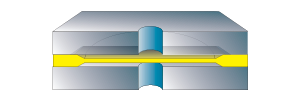
SL17 – Submersible Pressure Transmitter
SL17 – Submersible Pressure Transmitter
The Ashcroft® SL17 submersible transmitter combines ruggedness with proven sensor technology for satisfying challenging applications
Features & Properties
Use & Application
Downloads
Features & Properties
Use & Application
The Ashcroft® SL17 submersible transmitter proves ideal when consistent and reliable measurement is essential:
Process Market:
- Well Monitoring
- Pump Protection
- Tank level monitoring
- Municipal and Industrial water
Downloads
Data Sheets
- 📄 Data sheet submersible transmitter SL17 🇬🇧
- 📄 Data sheet submersible transmitter SL17 – TTS accessories 🇬🇧
Installation + Maintenance
Product + Technical Information
The Ashcroft® SL17 submersible transmitter provides a highly reliable platform for accurate pressure, level control and monitoring. Its small O.D. allows it to be dropped into smaller bore holes or to be more easily bundled with other instruments. The SL17 is ideal for groundwater monitoring applications.
Key Features
Desicant filters, surge protection, termination box and cable hangers available
Custom cable lengths
Excellent long term stability
Compact, 316L stainless steel housing and wetted materials
Small OD diameter (17mm) designed to fit narrow bore applications
Markets & Applications
Water and Wastewater
Well Monitoring
Level (groundwater/bore)
- Specifications
- Downloads
Ranges
0.1 ... 20 bar / 1 ... 200 meters H2O
Wetted Parts Material
Stainless steel 316L (1.4404)
Cable Material
Polyurethane
Ingress Protection
IP68 / NEMA 6P
Case or Body Material
Stainless steel 316L (1.4404)
Process Connection Style
Standard nose cone, weighted nose cone
Accuracy
0.25% of span
0.5% of span
Output Signal
4-20 mA (2-wire)
Stability
≤±0.25% span/year at reference conditions
Data Sheets
- 📄 Data sheet submersible transmitter SL17 🇬🇧
- 📄 Data sheet submersible transmitter SL17 - TTS accessories 🇬🇧
Installation + Maintenance
Product + Technical Information
- Category: Submersible Pressure Sensor
We’re glad to be there for you personally.
Siamo personalmente a vostra disposizione!
Nous sommes personnellement là pour vous.
Şahsen yanınızda olmaktan mutluluk duyuyoruz.
We zijn blij dat we er persoonlijk voor u kunnen zijn.
Wir sind persönlich für Sie da!
Siamo personalmente a vostra disposizione!
Nous sommes personnellement là pour vous!
Select your Region!










